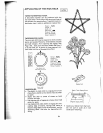
BUTTONHOLES
Various
fabrics
require
various
methods
of
sewing
buttonholes.
Four
different
methods
are
given
below,
with
suggested
uses.
If
you
are
in
doubt
as
to
which
method
is
best
for
your
fabric,
test
the
methods
in
question
and
choose
the
best
according
to
the
finished
appearance.
PREPARATION
For
the
best
results,
a
good
quality
merceriz
ed
cotton
thread
should
be
used.
Polyester
threads
often
result
in
puckered
or
heavy
unattractive
buttonholes.
The
finer
your
fabric
is,
the
finer
your
cotton
thread
should
be.
An
interfacing
should
be
used
under
the
buttonholes
to
give
body,
to
strengthen,
and
to
help
them
withstand
wear.
To
establish
the
correct
length
of
the
buttonhole,
add
the
diameter
of
the
button
(A),
plus
the
thick
ness
of
the
button
(B),
plus
1/8
inch
for
the
bartacks.
The
length
may
be
marked
on
the
garment
with
a
basting
stitch,
tailors
chalk,
or
transparent tape,
as
shown.
Another
way
to
make
sure
that
all
buttonholes
will
be
the
same
size
is
to
cut
a
piece
of
cardboard
as
wide
as
the
buttonhole
foot
and
long
enough
to
make
the
distance
between
the
toe
of
the
white
slide
and
the cardboard
the
size
buttonhole
needed.
This
method
works
for
buttonholes
up
to
1-1/8
inches
long.
Horizontal
buttonholes
should
extend
1/8
inch
beyond the
center
line
of
the
garment.
Vertical
buttonholes
are
placed
so
that
the
cutting
space
of
the
buttonhole
is
directly
on
the
center
line.
Always
make
a
practice
buttonhole
on
a
scrap
of
the
garment
fabric
before
making
any
buttonholes
on
your
gar
ment.
On
your
test
sample, duplicate
the
thickness
found
in
the
garment
and
be
sure
to
include
the
interfacing.
The
test
sample
should
help
determine
the
length
needed
for
the
button
to
pass
through
easily,
and
the
stitch
length
for
the
particular
fabric.
As with
the
satin
stitch,
the
stitches
should
be
close
together,
but
not
so
close
that
they
pile
up.
Be
sure
to
use
the
buttonhole
foot.
B
U
T
T
0
N
H
0
L
E
S
I
B
I
II
Center
line
of
Garment
inch
Center
line
of
Garment
29


















